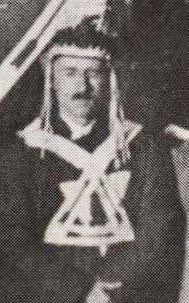Dr. William Hinkle presented the following report to the Grand Lodge in 1921:
Report of Committee on Ordeals and Ritual - 1921
The committee on Ordeals and Ritual beg leave to make the following report:
At the last annual meeting, the committee was requested to find a suitable name for the Lodge. After canvassing the matter thoroughly, the name - Unami - was decided to be the most appropriate, meaning as it does in the Delaware language - Brotherly Love.
As it was understood that meddlesome outsiders had access to the Ritual and became more or less familiar with it, at Treasure Island during the summer of 1920, it was decided to revise both the ritual for ordeals and for the different degrees, so that knowledge thus illicitly obtained might be useless.
The committee, furthermore, at the suggestion of Sakima, have prepared a ritual for the opening of the Lodge. A ritual for the installation and consecration of Sakima, and one for the installation of each of the elective officers of the Lodge (sic). It is hoped that those will meet with the approval of the Lodge, since by their use the Lodge will have work provided for one or two extra meetings during the year.
The committee further recommend that a Lodge of Instruction be formed so that there will always be a reasonable chance of having present at the meetings and initiations a sufficient number of officers who know this ritual well enough not to have to read their parts.
They also recommend that Sakima, with the Senior and Junior Vice-Chiefs have charge of this Lodge of Instruction: that at the annual election the only candidate be balloted for will be the Junior Vice-Chief – the old Junior becoming Senior, and the Senior becoming Sakima by complementary vote, unless there is reason for their removal, either through lack of interest, or some other cause. They also suggest that the candidates for Junior Vice-Chief be drawn from the Lodge of Instruction.
Finally, they strongly urge that the rituals finally adopted shall be limited to three copies. One in the hands of the Ritual Committee, one for Medeu, and one for Sakima. All other copies should be destroyed, and a pledge exacted from the holders of the three copies never to allow it out of their possession for any purpose whatever.
With reference to the adoption of the alternative ritual, patterned after the copy secured by Medeu, which is now in use by another Scout organization, they feel that while it has many commendable features, which appealed to them strongly; they, nevertheless, cannot recommend any change at the present time, as the ordeals seem somewhat too strenuous, to be imposed on boys of the age at which they become members of the W.W.W.
SIGNED FOR THE COMMITTEE
Dr. W. M. Hinkle
Chairman
The result of this report to the Grand Lodge was the writing of new First and Second Degree ceremonies for distribution to chartered lodges.
The new First Degree ritual contained significant changes. The Pre-Ordeal was introduced. There were two significant tasks that a candidate was asked to do.
The first task was that the candidate would bare his left breast and have water poured on the bare breast area. The water symbolized the cleansing experience to rid oneself of all selfishness and evil.
The second task was to chew on a piece of rootstock that was supplied to the candidate. This symbolized the increasing of strength and vigor so one could serve others.
The new First Degree ritual changed the names of some Principal characters and added others. Medeu became Gegeyjumhet (Supreme Chief of the Fire) Medicine Man became Meteu Sakima remained Sakima (Chief) Nutiket remained Nutiket (Guard/Guide) Nischeneyit Sakima is introduced as a new character (Senior Vice Chief) Pow-wow became Kittakima (Chief of the Fire) The new First Degree ritual also added a “closing ceremony”.
The new Second Degree ceremony made the same character changes as the First Degree. The ceremony was rewritten, but the content of the Second Degree ceremony was not changed.
3, Ceremonies, OA, Scouting
